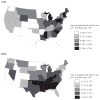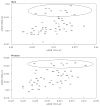Geographic Divergence in Mortality in the United States
- PMID: 25067863
- PMCID: PMC4109895
- DOI: 10.1111/j.1728-4457.2013.00630.x
Geographic Divergence in Mortality in the United States
Figures





Similar articles
-
Geography is more important than host plant use for the population genetic structure of a generalist insect herbivore.Mol Ecol. 2019 Sep;28(18):4317-4334. doi: 10.1111/mec.15218. Epub 2019 Sep 26. Mol Ecol. 2019. PMID: 31483075
-
From convergence to divergence: Lifespan variation in US states, 1959-2017.SSM Popul Health. 2021 Dec 4;16:100987. doi: 10.1016/j.ssmph.2021.100987. eCollection 2021 Dec. SSM Popul Health. 2021. PMID: 34917746 Free PMC article.
-
Geographic Variation in the Utilization of and Mortality After Emergency General Surgery Operations in the Northeastern and Southeastern United States.Ann Surg. 2022 Feb 1;275(2):340-347. doi: 10.1097/SLA.0000000000003939. Ann Surg. 2022. PMID: 32516232 Free PMC article.
-
Geographic variation in stroke mortality in blacks and whites in the United States.Stroke. 1997 Aug;28(8):1639-47. doi: 10.1161/01.str.28.8.1639. Stroke. 1997. PMID: 9259762 Review.
-
Geographic Variability in Liver Disease-Related Mortality Rates in the United States.Am J Med. 2018 Jul;131(7):728-734. doi: 10.1016/j.amjmed.2018.01.047. Epub 2018 Feb 26. Am J Med. 2018. PMID: 29496501 Free PMC article. Review.
Cited by
-
Medical financial hardship in the Southern United States: the struggle continues across generations pre- and post- the Affordable Care Act.Res Health Serv Reg. 2024 Sep 4;3(1):13. doi: 10.1007/s43999-024-00049-7. Res Health Serv Reg. 2024. PMID: 39227529 Free PMC article.
-
Life expectancy and geographic variation in mortality: an observational comparison study of six high-income Anglophone countries.BMJ Open. 2024 Aug 13;14(7):e079365. doi: 10.1136/bmjopen-2023-079365. BMJ Open. 2024. PMID: 39138004 Free PMC article.
-
An Assessment of Health Behaviours in Primary Care Patients: A Cross-Sectional Study.Healthcare (Basel). 2024 Jul 15;12(14):1405. doi: 10.3390/healthcare12141405. Healthcare (Basel). 2024. PMID: 39057548 Free PMC article.
-
Polysubstance Use among Maryland High School Students: Variations across County-Level School Districts.Int J Environ Res Public Health. 2024 May 17;21(5):639. doi: 10.3390/ijerph21050639. Int J Environ Res Public Health. 2024. PMID: 38791853 Free PMC article.
-
Jail Healthcare Staffing in the US Southeast: a Cross-Sectional Survey.J Gen Intern Med. 2024 Mar;39(4):603-610. doi: 10.1007/s11606-023-08454-3. Epub 2023 Oct 26. J Gen Intern Med. 2024. PMID: 37884837 Free PMC article.
References
-
- Burns David M, et al. Changes in Cigarette-Related Disease Risks and Their Implications for Prevention and Control, Smoking and Tobacco Control. Bethesda, MD: Cancer Control and Population Sciences, National Cancer Institute, US National Institutes of Health; 1997. Cigarette smoking behavior in the United States; pp. 13–112. Smoking and Tobacco Control Monograph no. 8, NIH publication no. 97-4213.
-
- CDC. State-specific smoking-attributable mortality and years of potential life lost—United States, 2000–2004,” (Reprinted from MMWR, vol. 58, pp. 29–33, 2009) Journal of the American Medical Association. 2009;301(9):928–929.
-
- CDC. Smoking and tobacco use; Data and statistics; Tables, charts, and graphs; Trends in state and federal cigarette tax and retail price. Smoking and Tobacco Use. 2011 « http://www.cdc.gov/tobacco/data_statistics/tables/economics/trends/index...».
-
- Chaloupka Frank J. Macro-social influences: The effects of prices and tobacco-control policies on the demand for tobacco products. Nicotine and Tobacco Research. 1999;1(Supp 2):S77–S81. - PubMed
Grants and funding
LinkOut - more resources
Full Text Sources
Other Literature Sources

